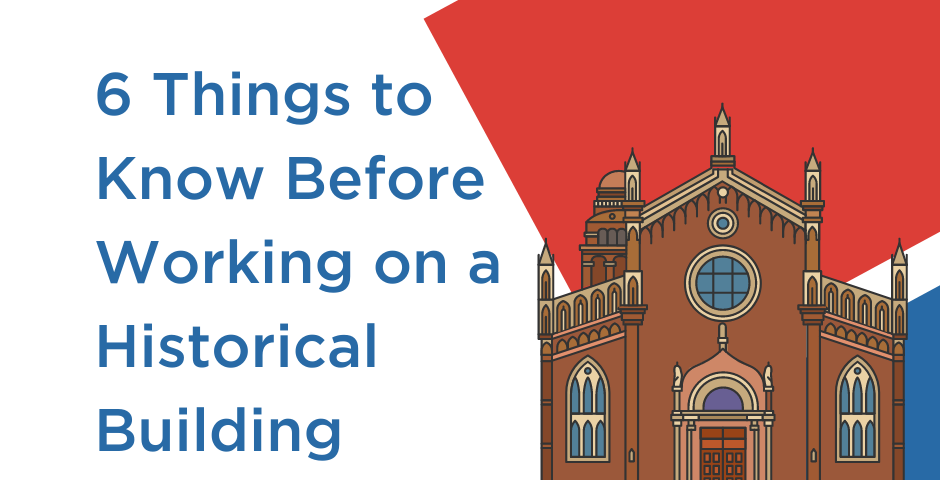
Restoring a historical building can be an incredibly rewarding experience, but it is not a project to be taken lightly. Even if the work you have planned would ordinarily be covered by Permitted Development, historical buildings have their own set of limitations and regulations.
In this article, we are going to be looking at the most important things you should know before you begin working on a historical building.
What is a Historical Building?
Historical buildings (also referred to as Listed Buildings) are buildings that are considered to have a particular historical or architectural significance. As such, these buildings and the changing of them are subject to regulations that are intended to preserve the building's unique character as best it can.
Grade II listed buildings can include:
- A home of historical importance
- An architectural wonder
- A home located in an area of historical interest
There are a number of laws that affect what can and cannot be done to a Grade II listed building. These laws apply to both internal and external renovations, repairs, and extensions.
It is also important to note that any building or renovation works cannot begin on a historical building without explicit consent from the local authority.

Permission Needed to Alter Historical Buildings
Perhaps the most important thing to know before working on a historical building is the permissions that are required before the work even begins. Even if the proposed works are usually covered by Permitted Development, these exclusions do not apply to historical buildings.
Before you begin on a historical building, you are required to get listed building consent. This occurs to all building works, including:
- Demolitions
- Alterations and repairs
- Extensions
Listed Building Consent is required by law for any works that may affect the character of the building. It is important to note that consent is needed for all parts of the historical building that are covered by the listing protection.
Remember that not seeking consent for works on a listed building is a criminal offence, and not knowing that the building was listed is not a defence. Ensure you are familiar with every part of the building that is covered by the listed building protection before you begin.
How to Apply for Listed Building Consent
Listed building consent must be acquired from your local authority before any works on the property may begin.
You may also need to apply for planning permission if any of the planned works are going to impact the external appearance of the building. If planning permission is necessary then it can be applied for at the same time you apply for listed building consent.
If you are uncertain whether the building you are planning to work on is covered by Listed Building Protection, then consult your local authority before you start any work. If you continue without permission, any works you have completed may need to be reversed and you may face legal consequences.
What You Can Do to a Historical Building
There are a number of building works that can be undertaken on a historical building once you have the consent to do so. These include:
- Repairs
- Internal alterations
- Renovation
- Extensions
However, while these changes may be approved, there are a number of limitations and rules that have to be adhered to when it comes to historical buildings.
How to Repair Historical Buildings
General maintenance and upkeep of a historical building can be undertaken and often without written consent from the local authority. This can include repairing plumbing, paint jobs, floorboards, and more. However, you should note that when undertaking repairs, like-for-like materials should be used to help maintain the character of the building.
This even applies to something as simple as a broken window. While just replacing the window might seem the obvious choice, this is still considered as something that can change the external appearance of the building. As such, the local authority would be well within their right to refuse any proposed replacements.
In these instances, repairing the damage is preferable to replacing the window entirely as the idea is to. If repairs are not possible, then the replacement window must look like the one that was broken.
With historical buildings being a bit more dated when it comes to materials, then there’s always a chance that the exact materials may not be available. In this instance, you will have to replace the broken part with something that looks like the original.

Interior Alterations in Historical Buildings
The regulations on a Grade II building apply to the entire property; internal and external. This means that any changes that are made to the internal structure of the building will need written consent. These include:
- Changing the layout
- Removing or adding walls
- Exposing timber or brickwork
- Installing double glazing
- Removing/ changing internal features (such as staircases and fireplaces)
Always remember to see written consent from the local authority before beginning any building works, as anything done without consent may have to be put back as it was.
Extending a Historical Building
Extending a listed building is a possibility, especially if the building has been previously extended. That said, Planning Permission and Building Regulations approval may be required to extend your house.
The most important thing to remember when considering extending a listed building is that the proposed works must not overpower what is already there.
Any extensions should also not dominate the existing building, meaning that they should be lower and smaller. What kind of extension would be permitted on a historical building will depend on the size, character, and setting of the property as well as the judgement of the local authority.
There will be instances where an extension on a listed building will not be possible. Extensions on historical buildings are more likely to be accepted if they are built onto the back of the house and cannot be seen from the front. The same may apply to side extensions as well.
Important things to keep in mind when building an extension on a listed building are:
- Connecting doorways — Where the door goes will need careful planning. If there is an existing doorway, then this would be ideal to avoid removing any historic walling. In some historic buildings, removing part of the wall to form a doorway may also cause some structural problems.
- Materials — All the exteriors of the extension must match or, at the very least, resemble the existing building. This goes for the walls, roof and windows.
If you wanted to incorporate a more modern design for your extension, then this may be possible. However, it will require very careful planning and still needs to be approved before work can begin.
Building works on a historical building can be a daunting task, but so long as you are following the correct procedures and complying with Building Regulations and have the correct permissions, then there is no reason the job cannot be achieved with great results.
If you are planning to start a new building project and you’re in need of some essentials, then why not browse through our range of trade building supplies available from us at Fastbuild?




